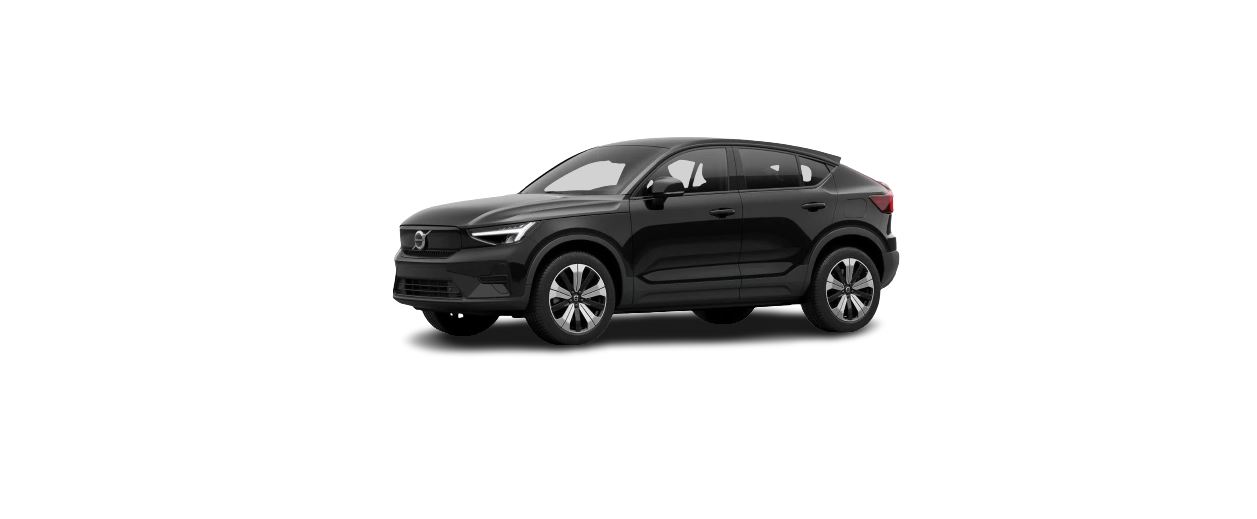Warning
- If a wheel must be changed in a trafficked environment, passengers must stand in a safe place.
- Use a jack(For jack recommendations, contact an authorised Volvo workshop) designed for the car when changing tyres. Use supports to secure the car for all other work.
- Never crawl under the car or reach under with a part of your body when it is raised on a jack.
- Passengers must leave the car when it is raised on the jack.
ImportantIf a jack(For jack recommendations, contact an authorised Volvo workshop) is included with the car, it is only designed for occasional, short-term use, such as when changing a wheel after a puncture. Only the jack belonging to the specific model is to be used to jack up the car. If the car is to be jacked up more often, or for a longer time than is required just to change a wheel, use of a garage jack is recommended. In this instance, follow the instructions for use that come with the equipment.
When the jack is not in use it should be stored in its storage space under the cargo area floor. Crank the jack down for it to fit.
Removing a wheel
Read through all instructions before beginning. Take out the tools needed before jacking up the car.
- Activate the hazard warning flashers and set out a warning triangle if a wheel shall be changed in a trafficked location.
- Make sure that the parking brake is activated and engage gear position P.
- Chock in front of and behind the wheels that remain on the ground. Use, for example, heavy wooden blocks or large stones.
- Screw together the towing eye with the wheel wrench(For wheel bolt wrench recommendations, contact an authorised Volvo workshop) to the stop position.
- Remove the plastic caps from the wheel bolts with a suitable tool or pull off the wheel cap .
With the car still on the ground, use the wheel bolt wrench/towing eye to undo the wheel bolts ½–1 turn by pressing downwards (anticlockwise). Always start with the lockable wheel bolts. Follow the instructions on how to safely raise the car with the jack. Raise the car high enough to allow the wheel to be removed to move freely. Remove the wheel bolts and lift off the wheel.
Mounting a wheel
- Clean the surfaces between wheel and hub.
- Put on the wheel. Ensure that the correct dimension is fitted in the correct position for cars with different front and rear tyre or wheel dimensions. Tighten the wheel bolts thoroughly. Do not use lubricant on the threads of the wheel bolts.
- Lower the car so that the wheels cannot rotate.
- Tighten the wheel bolts crosswise. It is important that the wheel bolts are tightened properly. Tighten to 140 Nm (103 foot-pound). Check the tightening torque with a torque wrench.
Depending on tyre equipment:
- Place the wheel cap back over the wheel nuts by making sure it fits using guide markers, then press it into place.
- Refit the plastic caps over the wheel bolts. Check the tyre pressure and save the new tyre pressure in the system for tyre pressure monitoring.
WarningThe wheel bolts may need to be re-tightened several days after the wheel change. Temperature differences and vibration may mean that they are not attached equally as tightly.
Note
- After a tyre has been inflated, always refit the dust cap in order to avoid damage to the valve from gravel, dirt, etc.
- Only use plastic dust caps. Metal dust caps can rust and become difficult to unscrew.
Jack(Option/accessory)
important
a jack(For jack recommendations, contact an authorised Volvo workshop) is included with the car, it is only designed for occasional, short-term use, such as when changing a wheel after a puncture. Only the jack belonging to the specific model is to be used to jack up the car. If the car is to be jacked up more often, or for a longer time than is required just to change a wheel, use of a garage jack is recommended. In this instance, follow the instructions for use that come with the equipment. When the jack is not in use it should be stored in its storage space under the cargo area floor. Crank the jack down for it to fit. The jack needs to be cranked together to the correct position in order to have space.
Wheel bolts
WarningThe wheel bolts may need to be re-tightened several days after the wheel change. Temperature differences and vibration may mean that they are not attached equally as tightly.
ImportantThe wheel bolts must be tightened to 140 Nm. (103 foot-pounds). Overtightening or loose tightening may damage the nuts and the bolts.
Lockable wheel bolt kit(Option/accessory)
To loosen or tighten the lockable wheel bolts – turn the wrench in the lock bolt until it fully engages in the code grooves. Always start with the lockable wheel bolts if the wheel shall be removed. When fitting the wheel, finish with the lock screw.
ImportantRemember not to use bending force when you loosen/tighten the wheel bolts. This could damage the code groove in the lock bolt and the wheel wrench and so make it impossible to fit/remove the wheel. When the wheel wrench(For wheel bolt wrench recommendations, contact an authorized Volvo workshop) is not in use it must be stored in its place in the storage compartment under the bonnet. It is important to remember this if the car is due to visit a workshop in order to have the tool available. If you lose the wrench, contact your Volvo dealer.
Spare wheel(Option/accessory)
Warning
- Never drive faster than 80 km/h (50 mph) with a spare wheel fitted on the car.
- The car must never be driven fitted with more than one “Temporary Spare” wheel.
- The car may have different driving characteristics while driving with the spare wheel. The spare wheel must be replaced with a normal wheel as soon as possible.
- The spare wheel is smaller than the normal wheel, which affects the car’s ground clearance. Look out for high kerbs and do not machine-wash the car.
- Follow the manufacturer’s recommended tyre pressure for the spare wheel.
- On all-wheel-drive cars, the drive on the rear axle can be disengaged.
- If the spare wheel is fitted to the front axle then it is not possible to use snow chains at the same time.
- The spare wheel must not be repaired.
important
car must not be driven with tyres of different dimensions or with a spare tyre other than the one the car is approved for. Using tyres of different dimensions can cause serious damage to the car’s transmission due to the different rolling circumferences. Cars designed for different front and rear tyre or wheel dimensions must have the same type and make of tyres on the front and rear axles.
Handling the spare wheel(Option/accessory)
The illustration is generic and its appearance may differ. The spare wheel is stored in a bag and must be secured with two straps on the floor of the cargo area while driving. The straps must be tensioned crosswise over the wheel and attached in the car’s four-load retaining eyelets. Tools for changing wheels are located under the cargo area floor.
Snow chains
In the event of uncertainty about the show chain, Volvo recommends that an authorised Volvo workshop should be contacted. The wrong snow chains may cause serious damage to the car and lead to an accident.
Using snow chains may result in a malfunction of the tyre pressure monitoring system.(Option/accessory.)(Indirect Tyre Pressure Monitoring System (ITPMS)).
Important
Snow chains can be used on the car with the following restrictions:
- Always follow the mounting instructions from the manufacturer carefully. Fit the chains as tension as possible and tension them at regular intervals.
- Snow chains must only be used on the front wheels (also applies to all-wheel drive cars).
- In some cases, snow chains must NOT be used, such as if accessory, aftermarket or “special” tyres and wheels are fitted that have a different size to the original tyres and wheels. Sufficient distance must be maintained between the chains and brakes, suspension and body components.
- Check local regulations with regard to using snow chains before fitting them.
- Never exceed the chain manufacturer’s specified maximum speed. You must never exceed 50 km/h (30 mph) under any circumstances.
- Avoid bumps, holes or sharp turns when driving with snow chains.
- Avoid driving on bare ground as this wears out both the snow chains and tyres.
- Driving with snow chains may have a negative effect on the car’s driving characteristics. Avoid fast or sharp turns, as well as braking with locked wheels.
- Some types of chains that are firmly tensioned affect brake components and must therefore NOT be used.
You can obtain more information on snow chains from a Volvo dealer.
Winter tyres
Tips for changing to winter tyres
When summer and winter wheels are changed, mark which side of the car they were mounted on, for example, L for left and R for right.
Contact a Volvo dealer for advice about which wheel rim and tyre types are most suitable.
Studded tyres
Studded winter tyres should be run in gently for 500-1000 km (300-600 miles), so the studs settle properly into the tyres. This gives the tyre, and especially the studs, a longer service life.
Tread depth
Road conditions with ice, slush and low temperatures place considerably higher demands on tyres than summer conditions. Volvo, therefore, recommends not to drive on winter tyres that have a tread depth of less than 4 mm (0.15 inches).
Punctures
Dealing with a puncture
The car is equipped with either a puncture repair kit for temporary tyre repair or a spare wheel, (Option/accessory.)see the respective section for user instructions.
Tool kit
Examples of tools that may be in the car.(For tool recommendations, contact an authorised Volvo workshop)
- Jack
- Tool for removing the plastic caps from the wheel bolts
- Emergency puncture repair kit(Temporary Mobility Kit)
- Wheel wrench and towing eye
If the car is fitted with a spare wheel, there is a jack and a wheel(Option/accessory) bolt wrench instead of an emergency puncture repair kit.




